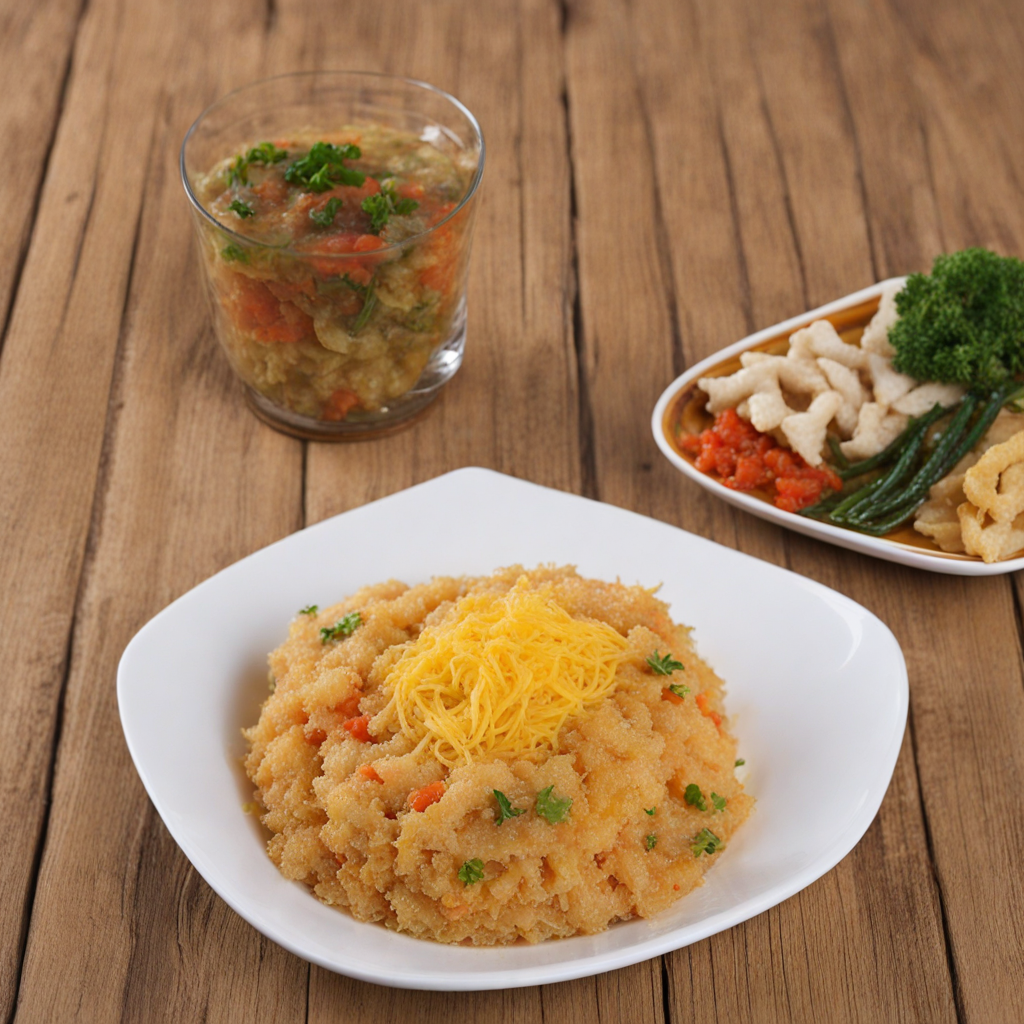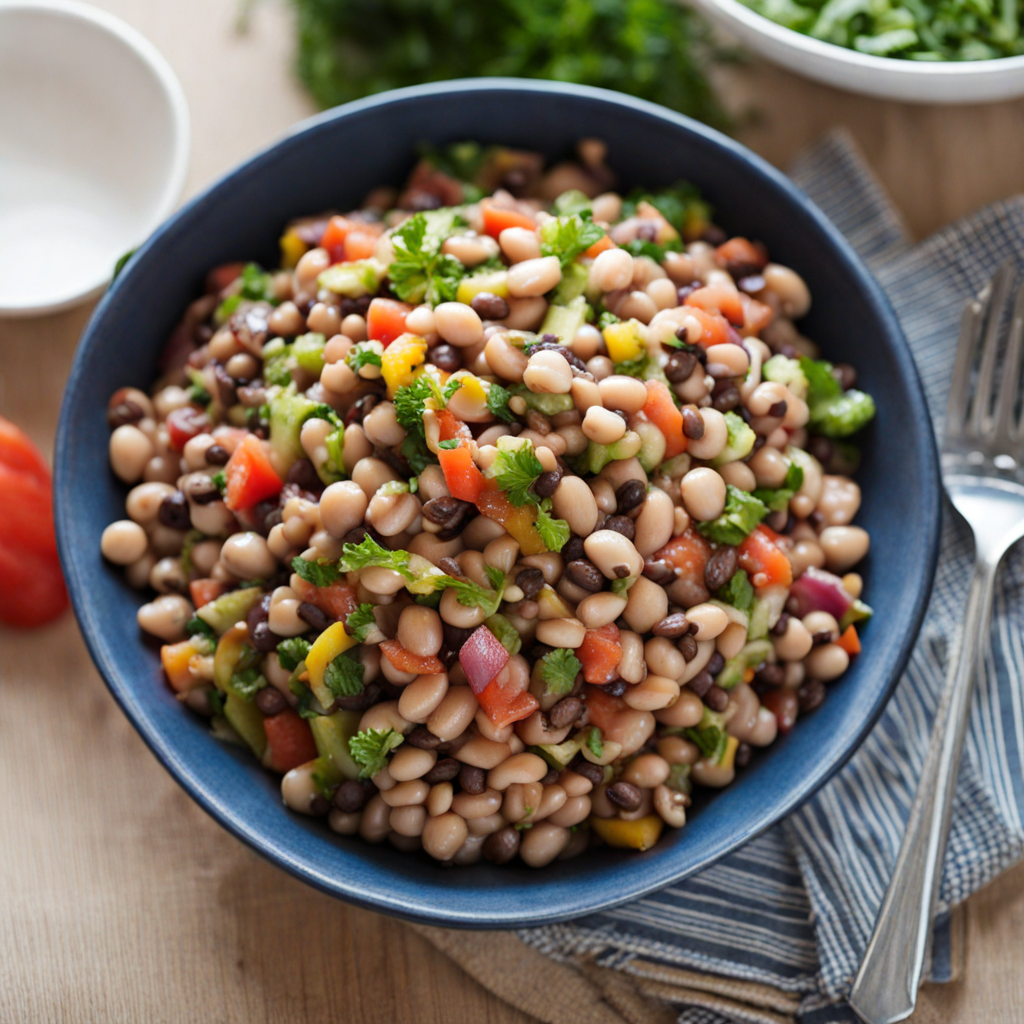Gari Foto
Gari Foto is a vibrant and hearty Ghanaian dish that beautifully showcases the flavors of West African cuisine. At its core, Gari Foto features gari, a coarse flour made from fermented and dried cassava, which serves as the primary ingredient. The gari is rehydrated and then combined with a medley of colorful vegetables, such as bell peppers, onions, and tomatoes. These ingredients are sautéed together, allowing the natural sweetness of the vegetables to meld with the slightly nutty and grainy texture of the gari, creating a dish that is both comforting and satisfying. To elevate the flavors of Gari Foto, it is often seasoned with a variety of spices and herbs, such as ground pepper, garlic, and ginger. This aromatic blend infuses the dish with warmth and depth, making each bite a delightful experience. Some variations of Gari Foto may also include protein sources like boiled eggs, fish, or meat, adding a savory element that enhances the overall taste profile. The dish is typically served warm, making it an ideal comfort food for any occasion. What sets Gari Foto apart is its versatility and adaptability. It can be enjoyed as a main dish or a side, allowing diners to customize their experience. The dish is not only hearty and filling but also embodies the essence of communal eating, where friends and family gather to share in the enjoyment of flavorful, home-cooked meals. With its unique combination of textures and flavors, Gari Foto offers a delightful exploration of Ghanaian cuisine, inviting food lovers to savor a true taste of West Africa.
How It Became This Dish
Gari Foto: A Culinary Journey Through Ghana's Rich History #### Origins of Gari Foto Gari Foto, a traditional Ghanaian dish, is a delightful blend of gari (fermented and toasted cassava flour) and a medley of vegetables, spices, and sometimes proteins. The dish is not just a culinary staple but also a reflection of Ghana's rich agricultural heritage and cultural diversity. The origins of Gari Foto can be traced back to the early 20th century when cassava, a root vegetable indigenous to South America, was introduced to West Africa. Over time, it became a crucial staple in the Ghanaian diet, particularly in the regions of the Volta and Eastern regions. Cassava's adaptability to various soil types and climates made it a popular crop among Ghanaian farmers. The process of transforming cassava into gari was developed as a means of preservation. By grating, fermenting, and toasting the cassava, farmers were able to create a product that could be stored for extended periods, which was vital in the face of seasonal fluctuations in food supply. #### Cultural Significance Gari Foto is more than just a dish; it embodies the spirit of Ghanaian culinary practices, which emphasize the use of locally sourced ingredients and traditional cooking methods. The dish is often prepared during communal gatherings, family celebrations, and local festivals, making it a symbol of togetherness and shared heritage. In Ghana, food is deeply intertwined with cultural identity. Gari Foto is typically served with a variety of sides such as fried plantains or stews, showcasing the country’s diverse culinary landscape. The dish often includes vegetables like tomatoes, onions, and peppers, which are staples in many Ghanaian meals. The vibrant colors and flavors of Gari Foto reflect the richness of Ghanaian agriculture and the creativity of its people. #### Development Over Time As Ghanaian society evolved, so did the preparation and presentation of Gari Foto. Initially, it was a simple dish made with minimal ingredients. However, as culinary influences from different cultures began to permeate Ghanaian kitchens, Gari Foto became more complex. Today, it can be made with a variety of proteins, including fish, chicken, or even legumes, catering to diverse palates and dietary preferences. The 20th century saw a significant transformation in Ghana's agricultural practices due to globalization and urbanization. With increasing access to international markets, Gari Foto began to incorporate ingredients that were not traditionally used. For instance, spices from the Middle East and South Asia have found their way into the dish, introducing new flavor profiles and cooking techniques. Moreover, as urban centers like Accra and Kumasi grew, the demand for quick and convenient meals surged. Gari Foto adapted to these changing lifestyles by becoming a popular street food option. Vendors began selling pre-prepared Gari Foto, making it accessible to busy city dwellers. This transition not only helped preserve the dish's relevance but also contributed to its popularity beyond traditional settings. #### Gari Foto in Contemporary Ghana In contemporary Ghana, Gari Foto continues to hold a significant place in both home cooking and street food culture. It is a common sight at social events, including weddings, parties, and funerals, where it is served alongside other traditional dishes. The dish is often accompanied by spicy sauces or stews, allowing for a personalized touch that appeals to individual tastes. Furthermore, the rise of social media and food blogging in Ghana has led to a resurgence of interest in traditional dishes like Gari Foto. Young chefs and food enthusiasts are experimenting with the dish, incorporating modern techniques and presentation styles while paying homage to its roots. This fusion of old and new has made Gari Foto a canvas for culinary creativity, with variations that reflect personal stories and regional ingredients. #### Nutritional Aspects Nutritionally, Gari Foto is a balanced dish, providing carbohydrates from the gari, vitamins from the vegetables, and proteins from the added ingredients. The health benefits of cassava are well-documented; it is gluten-free, rich in carbohydrates, and provides a source of energy. Additionally, the fiber content in the dish, particularly from the vegetables, contributes to digestive health. In a country where food security is a pressing issue, Gari Foto serves as a reminder of the importance of utilizing local resources efficiently. The dish encourages the consumption of seasonal and locally sourced produce, which is essential for sustainable agriculture and food systems. #### Conclusion Gari Foto is a testament to the resilience and adaptability of Ghanaian culinary traditions. From its humble beginnings as a simple meal to its current status as a beloved dish enjoyed across various settings, Gari Foto has evolved while maintaining its core essence. The dish encapsulates the stories of generations, reflecting the cultural significance of food in Ghanaian society. As Ghana continues to navigate the challenges and opportunities of a globalized world, Gari Foto stands as a symbol of pride and identity. It serves not only as nourishment but as a celebration of community, history, and the shared joy of a good meal. Whether enjoyed at a bustling street stall or a family gathering, Gari Foto remains a cherished part of Ghana’s culinary heritage, connecting the past to the present and paving the way for future generations to appreciate the richness of their culture through food.
You may like
Discover local flavors from Ghana







